Ader-Appels, Johanna Adriana, born 19-05-1906 in Driebergen  as the fifth and last child in a fairly well-to-do family, of the carpenter Dirk Appels and the midwife Johanna Adriana, born van Stam. Johanna married Bastiaan Jan Ade “Domie, born 30-12-1909 in ‘s Gravenzande,
as the fifth and last child in a fairly well-to-do family, of the carpenter Dirk Appels and the midwife Johanna Adriana, born van Stam. Johanna married Bastiaan Jan Ade “Domie, born 30-12-1909 in ‘s Gravenzande,  in 1935. Johanna’s husband became a Dutch Reformed minister in the church community of Nieuw-Beerta in 1938. The couple had one son, Bas Jan Ader (1942–1975)
in 1935. Johanna’s husband became a Dutch Reformed minister in the church community of Nieuw-Beerta in 1938. The couple had one son, Bas Jan Ader (1942–1975)  In 1975, Bas Ader was lost at sea between Cape Cod, Massachusetts, and England, when he was attempting a single-handed west-crossing of the Atlantic Ocean in a 13-foot pocket cruiser (a modified Guppy 13), named the ‘Ocean Wave.’ The boat was later found 10 months later floating partially submerged off the coast of Ireland, but no sign of Ader was ever found. When Ader’s widow Mary Sue Ader-Andersen arrived in Spain to see the boat, it was found to have been stolen.
In 1975, Bas Ader was lost at sea between Cape Cod, Massachusetts, and England, when he was attempting a single-handed west-crossing of the Atlantic Ocean in a 13-foot pocket cruiser (a modified Guppy 13), named the ‘Ocean Wave.’ The boat was later found 10 months later floating partially submerged off the coast of Ireland, but no sign of Ader was ever found. When Ader’s widow Mary Sue Ader-Andersen arrived in Spain to see the boat, it was found to have been stolen.
As a boy, Bastiaan Jan Ader Sr was very interested in technology and wanted to be an engine driver . He was also considered adventurous, creative and musical. At the age of 17 he finished high school and then went on to study theology at Utrecht University for five years . During his student days, he cycled to Lochem on Sundays to play the organ at church services. Bas Ader built up a network of resistance fighters. He developed a plan to liberate Jewish people from the Westerbork camp ; the plan was revealed. On 22-06-1944, he was arrested and executed on 20-11-1944 on a hilltop near Rhenen, in the so-called Schupse Bos,
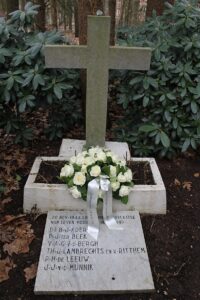
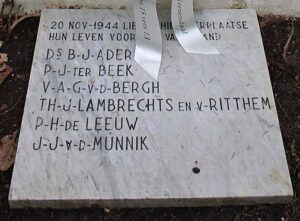 with five other resistance fighters, in retaliation for shots fired at a German officer two days earlier. These other victims were Pieter Julius Terbeek, age 23
with five other resistance fighters, in retaliation for shots fired at a German officer two days earlier. These other victims were Pieter Julius Terbeek, age 23  Victor Alexander Guillaume van de Bergh, age 26
Victor Alexander Guillaume van de Bergh, age 26  Thomas Jan Lambrechtsen van Ritthem, age 22
Thomas Jan Lambrechtsen van Ritthem, age 22  Philip de Leeuw, age 30
Philip de Leeuw, age 30  and Jan Johannes van den Munnik, age 20,
and Jan Johannes van den Munnik, age 20,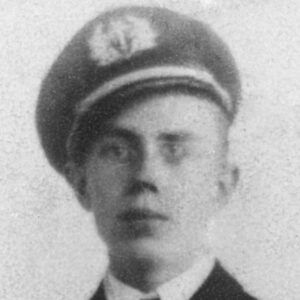
Johanna did MO-A English in Utrecht and would later also follow theology courses. In the early thirties she met her future husband, They married in September 1935,  after his bachelor’s degree in theology. In the summer of 1936 he left for an adventurous bicycle trip to the Holy Land, with her permission and full support, also financially. At that time Jo worked as an editor at an Amsterdam publishing agency.
after his bachelor’s degree in theology. In the summer of 1936 he left for an adventurous bicycle trip to the Holy Land, with her permission and full support, also financially. At that time Jo worked as an editor at an Amsterdam publishing agency.
On his journey through the Middle East, the young pastor was deeply impressed by the selfless work he saw of Protestant missionaries in the region and the couple considered doing the same, but eventually decided to stay in Europe so as not to run away from the impending disaster. In October 1938, they moved to the village of Nieuw-Beerta in North-East Groningen, where he had been called as a pastor. There they found the challenge they were looking for: the population had become largely communist and atheistic, influenced by the extreme income differences between farmers and their farm workers and by the great liberalism of previous pastors who had virtually stripped the gospel of its content. Jo worked side by side with her husband in the congregation.
On his journey through the Middle East, the young pastor was deeply impressed by the selfless work he saw of Protestant missionaries in the region and the couple considered doing the same, but eventually decided to stay in Europe so as not to run away from the impending disaster. In October 1938, they moved to the village of Nieuw-Beerta in North-East Groningen, where he had been called as a pastor. 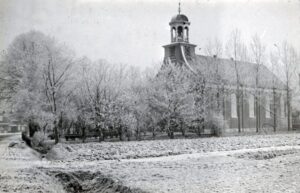 There they found the challenge they were looking for: the population had become largely communist and atheistic, influenced by the extreme income differences between farmers and their farm workers and by the great liberalism of previous pastors who had virtually stripped the gospel of its content. Johanna worked side by side with her husband in the congregation.
There they found the challenge they were looking for: the population had become largely communist and atheistic, influenced by the extreme income differences between farmers and their farm workers and by the great liberalism of previous pastors who had virtually stripped the gospel of its content. Johanna worked side by side with her husband in the congregation.
Their lives remained relatively untouched by the German occupation during the first years. That changed when a Jewish acquaintance from Amsterdam wrote to them asking if she could come and hide under their roof from the occupier and his henchmen. The answer was positive and accompanied by the suggestion that she, Lilly Johanna Samuëls,  bring someone else to prevent the boredom of their lack of freedom. It would be the beginning of the couple’s increasingly deep involvement in the resistance. Based on its own research, Yad Vashem
bring someone else to prevent the boredom of their lack of freedom. It would be the beginning of the couple’s increasingly deep involvement in the resistance. Based on its own research, Yad Vashem  estimates that, with the help of many, they brought between two and three hundred Jewish compatriots to safety.
estimates that, with the help of many, they brought between two and three hundred Jewish compatriots to safety.
After Reverend. Ader was betrayed by a villager in 1944, he and the people in hiding had to quickly find other addresses. Lilly and her friend returned to Amsterdam, were arrested and sent from Westerbork  to Auschwitz.
to Auschwitz.  In November 1944, Reverend. Ader, age 34 and five fellow resistance fighters were shot dead by the Germans.
In November 1944, Reverend. Ader, age 34 and five fellow resistance fighters were shot dead by the Germans.
On 19-04-1942 their first child, Bastiaan Johan Christiaan (Basjan) was born,  followed by Diederik Antonius Viktor Emanuël (Erik) on 04-11-1944. Reverend. Ader had been imprisoned since 22 July of that year and on 20-11-1944 he was shot by the occupying forces.
followed by Diederik Antonius Viktor Emanuël (Erik) on 04-11-1944. Reverend. Ader had been imprisoned since 22 July of that year and on 20-11-1944 he was shot by the occupying forces.
The diary that Johanna kept in the utmost secrecy during the war formed the basis for the book she wrote about those years, called ‘Een Groninger Pastorie in de Storm’.  The book went through thirteen editions and was translated into German and Finnish and recently into English under the title ‘House of Defiance’.The former person in hiding Johanna-Ruth Dobschiner
The book went through thirteen editions and was translated into German and Finnish and recently into English under the title ‘House of Defiance’.The former person in hiding Johanna-Ruth Dobschiner  devoted part of the book she wrote about that period to her time in the parsonage under the title: ‘Te mag leven!’
devoted part of the book she wrote about that period to her time in the parsonage under the title: ‘Te mag leven!’ 
Death and burial ground of Ader-Appels, Johanna Adriana “Jo” and her husband Bastiaan Jan Ader.
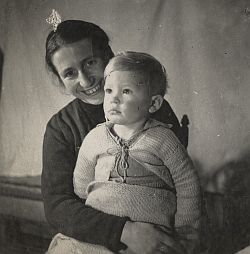
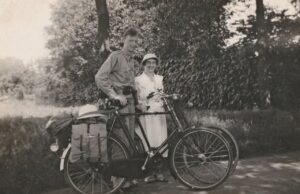
After the war, the church council appointed a new minister. Johanna moved to the neighbouring village of Drieborg, which was part of the church community. There she devoted herself to founding a building that could serve as a base for all the association activities that she and her husband had set up there and that could also serve as a church space. In 1948 she had a house built from her private assets and in 1950 the building, a deep wish of her husband, could be opened. The money was raised from the income from her book and her lectures and from donations from people who were fond of her work. She worked there until she was well into her seventies and could no longer because her mind was increasingly clouded by Alzheimer’s disease. Shortly before her retirement she was appointed minister by the Reformed Church. Johanna died on 31-07-1994, age 87, and was buried in the new cemetery of Nieuw-Beerta. After the war, Rev. Ader was buried in the Field of Honor in Loenen. Johanna had set up a foundation as the financial basis for the work in Drieborg. This foundation still exists and received a substantial donation from Johanna’s private assets. The foundation supports church work in the region by contributing to the maintenance of a ministerial position. The youngest son, Erik,  became a Dutch ambassador and is the chairman of the Reverend. Ader Foundation. The eldest son is the internationally renowned artist Bas Jan Ader, who went missing at sea in 1975. Many turn to his youth and background for an interpretation of his work, and with good reason. ‘
became a Dutch ambassador and is the chairman of the Reverend. Ader Foundation. The eldest son is the internationally renowned artist Bas Jan Ader, who went missing at sea in 1975. Many turn to his youth and background for an interpretation of his work, and with good reason. ‘
Johanna Ader-Appels was awarded the Resistance Commemorative Cross  and was a Knight in the Order of Orange-Nassau
and was a Knight in the Order of Orange-Nassau ![]() . She also received the award (no. 423) for Righteous Among the Nations from the Israeli memorial center Yad Vashem in 1967.
. She also received the award (no. 423) for Righteous Among the Nations from the Israeli memorial center Yad Vashem in 1967.
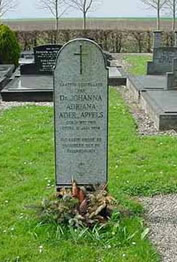
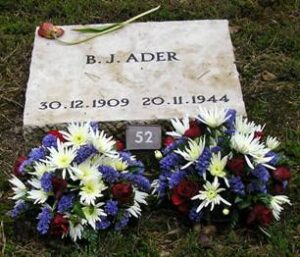





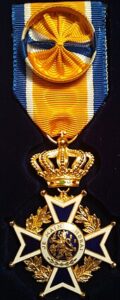












Leave a Reply